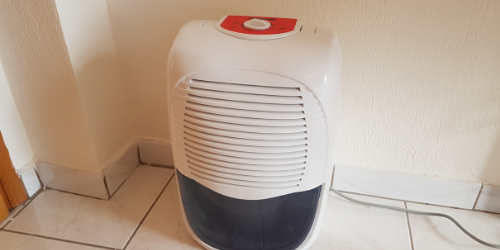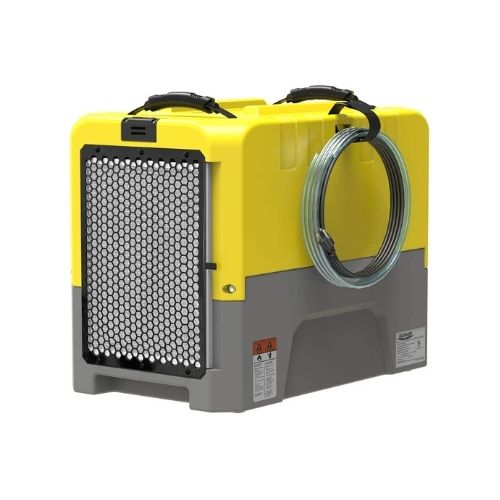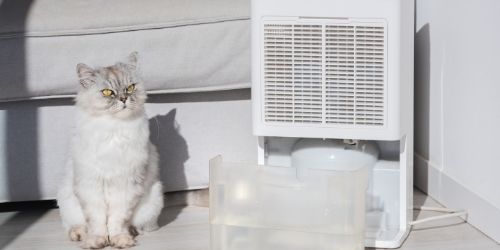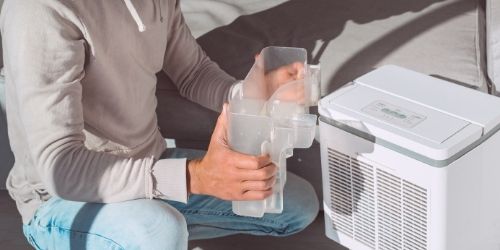Dehumidifier desiccant vs compressor
3 Key Takeaways:
🚀 Desiccant dehumidifiers use a drying material to absorb moisture from the air, while compressor dehumidifiers use a refrigerant to condense moisture from the air.
🚀 Desiccant dehumidifiers are more durable, quieter, and more economical than compressor dehumidifiers, but they may not be as effective in high humidity levels.
🚀 Compressor dehumidifiers are highly efficient in removing excess moisture from the air and are recommended for large areas in need of dehumidification.
Know the difference between desiccant and compressor dehumidifier.
High humidity levels are a constant battle in most homes. Keeping an indoor space free from moist air is crucial for several reasons. Reducing humidity is not just about extracting moisture from the air for the sole purpose of creating an ambient temperature. Balancing the relative humidity levels is about protecting your home against the damaging effects that come along with it. Be it mold and mildew, fungal growth, musty smell, dust mites, allergens, structural damage, etc.
All thanks to domestic dehumidifiers that make reducing humidity and keeping damp air away is an easy task.
However, the confusion of which type of dehumidifier is the right choice against battling the humid air in your home does exist.
Could they be Compressor Dehumidifiers or Desiccant Dehumidifiers?
Let us look into detail in this article on how compressor dehumidifiers work and what are the advantages of a desiccant unit and more. Find out which would be the ideal choice for your pocket and for your indoor space. Desiccant unit or Compressor unit?
Before we head to finding out if your home needs a desiccant or compressor unit, let us be clear about how each of these dehumidifiers works.
Compressor Dehumidifier

The popular compressor dehumidifier type is the large plug-in dehumidifier that most people are familiar with. There are different models and technological advancements to the compressor units that make them highly efficient in removing excess moisture from the air.
A typical compressor-based dehumidifier is identified by its audible fan and capacity to easily remove the moisture of about 30 pints from the atmosphere, over a period of 24 hours! If the area in need of the dehumidification process is a fairly large one, most professionals recommend investing in compressor units.
This is how the compressor model works to keep a space free from excess moisture and musty smell- the condensation mechanism. Reducing humidity levels is done by building a cold surface. This cold surface is on the refrigerated coil that is placed within the compressor unit. When warm air passes over the cold surface of the refrigerated coil, via the condensation mechanism, the unit will remove moisture from the air (as water), and collect this water in the reservoir within the compressor unit. This collected water can be drained to the outside by various methods based on your convenience.
Desiccant Dehumidifier

Desiccant units or thermo electric models are equally famous as their compressor counterparts. The thermo electric models are famous for their silent operation. These do not generate fan noise and are hence quieter.
Here is how the drying process or the dehumidification process in a desiccant dehumidifier works. A desiccant unit depends on a ‘Desiccant wheel’ to function. This desiccant wheel will absorb the excess moisture from the humid air. The seamless functioning of the dehumidification process is taken care of by the desiccant wheel, which can be recharged using an electric heater (when the desiccant wheel is saturated).
Having understood the operation of both types of dehumidifiers, let us head to analyze ‘Compressor Vs Desiccant’ by going over the parameters to identify a good performing dehumidifier when it comes to maintaining relative humidity levels.
Comparing Desiccant and Compressor Dehumidifiers:

Humidity Control
Humid air that hangs around the room is a major problem that both desiccant and compressor dehumidifiers aim to cover. Indefinitely, one is an advantage over the other when it comes to certain conditions. These conditions will entirely depend on what your need is.
Maintaining the ideal ambient temperature sometimes could be possible but just making some changes in your indoor practices. Poor ventilation, laundry indoors, washing indoors, cooking indoors are few major contributors that increase the relative humidity levels in a closed space. This can also be in the case of an RV or travel trailer.
Practising better management of these contributors can help to control the build-up of damp air to an extent. You can avoid these factors that lead to warm air and couple it with the action of desiccant or compressor dehumidifiers. Remember, the choice of dehumidifiers for any space will depend on the room temperature, relative humidity level, area of the space to cover.
For Drying Clothes
Here is how washing indoors can be handled using dehumidifiers. It is a fact that one of the most common reasons why people deal with condensation and mold growth indoors is because of laundry indoors. You can use either a desiccant or compressor dehumidifier to create a dry atmosphere and blow the dry air across the wet washing. This is indeed a brilliant way to dry wet laundry quickly. This method will ensure that all the moisture from the wet clothes will go into the dehumidifier, rather than simply spreading around the home and shooting up the relative humidity level.
It can be noticed that drying washing is very similar to how clothes are line-dried under the hot sun. Once the warm air from the dehumidifier hits the wet clothes, it takes in the excess moisture from the air and the clothes. You get dry clothes and dry air!
To answer the question, ‘Which dehumidifier dries clothes faster in the battle of compressor vs desiccant?’; here is our answer. Desiccant dehumidifiers are found to have faster airflow in comparison to their compressor counterparts. One model, in particular, is found to be highly effective. The Meaco 25L Low Energy Dehumidifier is specially designed to operate as an excellent alternative to the tumble dryer. This unit has a massive top speed on its airflow to hasten the drying process.
Running Costs
You might be surprised to learn that the way in which compressor dehumidifiers work will actually be gentler in your pockets, in comparison to their desiccant counterparts. Although compressor units are large, they are energy efficient and give you a lesser electricity bill than the desiccant models.
Considering that dehumidifiers are used extensively during cold temperatures, they are going to take up a lot of attention from the dehumidifiers you have. Consuming less energy is going to be quite a difficult task. This is where the desiccant units come in with their passive heating process. This might be what you need and even work better for longer hours of use with their slow heating process, despite the fact that you might have a higher electricity bill. Hence in the compressor vs desiccant model battles, as far as the electricity bill is concerned, you can make use of the desiccant model.
Basements are known to run into low temperatures easily. Ensure no matter which model you purchase, the dehumidifier works and is equipped to do so and to withstand the cold temperatures. The strained working shuttling between warmer temperatures and sudden drop to cold temperature might also place a strain on the function of the device, which is a contributing factor to shoot up the electricity bill.
Maintenance
Which one should you pick if you are looking for a dehumidification process with easy maintenance?
Desiccant or compressor dehumidifiers?
The answer is desiccant dehumidifiers. Desiccant units simply need to be recharged when they have reached their full potential. You can recharge them and place them again amidst humid air to get dry air in the room or space they are in.
On the other hand, compressor units are complicated. They are advanced and use refrigerant gas to undertake the dehumidification process. If there is a drop in the maintenance of relative humidity levels by compressor units, the professional might check if the device has run out of refrigerant gas (among the other parts and details of the operation that will be checked).
You might want to remember that refrigerant gas is expensive. Moreover, the internal parts of the compressor dehumidifiers are also complex. Although compressor dehumidifiers work far efficiently in comparison to their desiccant counterparts; especially when it comes to relative humidity control across an indoor space with a large area, these are expensive to maintain. If the area that is filled with humid air is fairly small, you can resort to desiccant dehumidifiers.
Capacity
Undoubtedly, high ambient temperatures with less energy consumption are the perfect deal that only compressor dehumidifiers can give you. If your indoor space is desperately in need of drier air, and having air conditioners does not help, it can only mean you need a high-capacity dehumidifier.
Sometimes, the density of humid air in the room might be less and air conditioning the area for a short while would cause a change in the room temperature which can be good enough. If your intention is to achieve just this small change in room temperature, the capacity of desiccant dehumidifiers would be sufficient.
Desiccant model dehumidifiers will have an absorbent, most like silica gel, which has the capacity to act upon humid air, reducing humidity effectively to give you drier air. However, the capacity is minimal. The area battling high humidity cannot be large, nor can the density of the humidity levels.
On the contrary, compressor dehumidifiers can act upon large areas efficiently. A compressor model dehumidifier can cover even an entire home, say close to 2000 square feet. They can act upon high humidity levels and can remove moisture from the air. Compressor units come in different capacities depending on their moisture absorption ability. 30-pint dehumidifier, 70-pint dehumidifier, etc; based on the number of pints of water they absorb from the air.
Hence, in the capacity criteria if you were wondering about desiccant or compressor units; the answer is reflective of the purpose you aim to meet.
Noise
The noise level that both desiccant dehumidifiers and compressor dehumidifiers generate might be a huge cause of concern if you tend to place the dehumidifier in an area that cannot have loud noise going on. Most homes have dehumidifiers in their bedroom, even letting them run overnight; lounge area, restaurants, offices, etc. These places apart from benefiting from the ambient temperature and a nice cold room can also use some silence. Having a device running with a loud fan noise is definitely going to be disturbing.
When it comes to fan noise generation while operating, the desiccant model or thermo electric models are known to be quieter. Most desiccant models would not even generate more than 40 dB while the dehumidifier works to remove extra moisture from the air. If you opt for an option like the low fan speed mode, you might never notice a dehumidifier running in the room with you. However, when a desiccant dehumidifier works at high fan speed, the fan noise it makes might be equivalent to its compressor counterparts.
In a compressor model, on the other hand, all models would operate in a sound range higher than 40 dB. It is hard to quiet down these models while they work on extracting moisture from the air. However, there are recently available ‘Whisper Quiet’ models that will guarantee you the silent undisturbed operation. The most popular choice among them being the Mitsubishi electric range. This compressor model has a whisper-quiet mode of operation during extracting moisture.
Therefore as far as the noise level is concerned in the desiccant and compressor dehumidifiers battle, the winner is the desiccant dehumidifier.
Low-temperature operation
Checking how a dehumidifier works in environments with low temperatures is important. You must ensure that the unit that you have purchased is eligible and equipped with the capacity to withstand a drop in room temperature. There are certain features that facilitate the easy and seamless working of dehumidifiers in cold spaces. This is essential to maintain the longevity of your unit to help it carry out the drying process even in a cold room.
Let us look at how compressor dehumidifiers work in low temperatures. It is primordial for a compressor unit to maintain its inner portion colder than the air in the room. Say if the device is dealing with cold spaces, where the room temperature is dropping under 15°C, the compressor dehumidifier that you have will have to work harder to maintain a cold surface on the inside that is lesser than the room temperature. This is hard work!
If the room temperature keeps dropping and reaches close to 10°C, this means the inside of the dehumidifier is getting close to freezing point. When a refrigerated coil gets close to freezing point, the chances are high where it may develop ice formation. This mechanism of striving to maintain the cold surface is a similar concept in air conditioners as well.
To combat this ice formation, compressor dehumidifiers are designed with auto-defrost features. This will make the dehumidifier spend two-thirds of its time on defrosting. Ice build-up in a refrigerated coil will hinder the performance of the device. Reducing humidity, filtering dust mites, etc., will become a challenge.
In contrary to this performance, desiccant dehumidifiers are known to maintain a consistent performance at turning damp air into drier air, regardless of the room temperature fluctuations.
Warranty
Most companies offer a certain period of time as the warranty period for different appliances. Accessing how beneficial was the warranty period certainly depends on the product’s worth and performance. Are you wondering; compressor vs desiccant, which among these has a better warranty policy? The answer to your question is; ‘It is relative to the product’.
Our Verdict:
When should you use a desiccant dehumidifier?
If you find your list of requirements within these pointers, then you can use help from desiccant dehumidifiers for your home.
✔ Desiccant dehumidifiers are the best option for cold weather. Although their compressor counterparts are built to be sturdy for high ambient temperatures, the desiccant models are capable of maintaining consistent performance in reducing humidity despite room temperature fluctuations.
✔ You should use a desiccant dehumidifier if you want a low-maintenance dehumidifier since these do not use any refrigerant gas and require just recharging of the silica gel or which desiccant material they contain.
✔ Desiccant dehumidifiers are the most recommended choice for those looking for low noise level dehumidifiers. They operate very quietly.
✔ Desiccant models are the best portable dehumidifiers. While a compressor dehumidifier might weigh anywhere over 10 kgs, a desiccant model would weigh from 5 kgs to 9kgs. If there are other rooms in the house in need of damp air removal, you can move the desiccant dehumidifier to that place easily. A compressor dehumidifier cannot be moved around the house with ease. However, you can get an entire home covered for humid air removal with just one compressor dehumidifier (based on its pint capacity). If you are looking for a portable dehumidifier, desiccant dehumidifiers are the right choice.
✔ Desiccant dehumidifiers are a more durable option in comparison to how compressor dehumidifiers work. A compressor dehumidifier will require internal coil maintenance, refrigerated gas refilling, and more. However, this is not the case with how desiccant dehumidifiers work. Since they are just like a sponge or silica gel that simply absorbs the moisture via the desiccant wheel; it is sufficient if the wheel is regenerated by an inbuilt internal heater for the process to continue. You can expect less energy consumption from desiccant dehumidifiers.
When should you use a compressor dehumidifier?
If the following pointers meet your list, you might have to consider purchasing a compressor dehumidifier.
Compressor dehumidifiers thrive in warmer temperatures. This is mainly because of their internal coil whose cold surface has to remain colder than the room temperature that exists. High ambient temperatures are ideal to run compressor models. If your home is free from the risk of running into low temperatures you might be happy with how compressor dehumidifiers work.
Many compressor models are designed to give customers less energy level consumption. If your home and energy bill can use this, along with getting moisture removal, you can choose this model over the desiccant counterparts.
Which is the best desiccant dehumidifier?
If you have identified that your home needs a desiccant dehumidifier, you should look into Ivation 19-Pint Small-Area Dehumidifier. This desiccant unit has been designed to effectively remove the musty smell, dust mites, damp air, and mold. It can warm air in ambient temperatures and is indeed the perfect choice for colder weather.
Similar to how most desiccant dehumidifiers work, the Ivation model is also capable of giving whisper-quiet operation and humidity control for small spaces. It can cover an area of up to 410 square feet, be it in your home, laundry room, boat, or RV.
The Ivation desiccant dehumidifier has a high-capacity water tank that can hold 1/2 gallon of water.
The device comes along with a connection hose meant for continuous drainage. Other benefits of using this dehumidifier model are; user-friendly LCD display, a sleek and stylish digital interface with which you can power On/Off, adjust humidity, fan speed, timer and sleep mode, vent swing, and even adjust the screen brightness. The carry handle makes portability better and the washable filter ensures you get rid of dust mites thoroughly. If these features are what your home will need from a desiccant dehumidifier, you ought to look into this unit.
Pros and Cons of Ivation Dehumidifier
✦ Efficiently absorbs excess moisture from the air.
✦ Can keep home free from mold, mildew, musty smell, dust mites, and other allergens.
✦ Guarantees to send back drier air into the room.
✦ User-friendly design.
✦ Continuous drainage facility.
✦ Portability enhanced with easy-to-carry handles.
✦ Quiet operation.
✦ Desiccant units are built to be stable, however, the durability of this model can be improved.
Which is the best compressor dehumidifier?
There are plentiful compressor dehumidifier models available in the market. If you have arrived at the decision to purchase a compressor dehumidifier to meet your home requirements, it is advised to go after the best among them. HOmeLabs 4,500 square feet Dehumidifier is the highly recommended compressor dehumidifier model. Let us learn more about its features and advantages.
This large 50 pints dehumidifier comes with the capacity to hold 1.6 gallons of water and cover an area of 4,500 sq ft. Despite its large size and capacity, this compressor dehumidifier has a stylish design, caster wheels for portability, and even a quiet fan!
The other beneficial features of this compressor dehumidifier are; automatic shut off of the unit when the tank is full, alert when the water take is full, continuous 24-hour cycle, auto restart, drain hose outlet for continuous drainage facility, Turbo mode to increase the fan speed from normal to CFM 188 (for enhanced moisture removal and musty smell removal).
This compressor dehumidifier is Energy Star certified, which means you can be assured of getting a low electricity bill from this energy-conserving design. Are these features for your home? If yes, consult with a certified professional before you make the purchase.
Pros and Cons of HOmeLabs Dehumidifier
✦ Highly efficient moisture absorption; suitable for full home, basements, offices.
✦ Can cover an area of 4,500 square feet.
✦ Continuous drainage facility.
✦ Energy Star model.
✦ User-friendly design.
✦ Caster wheels for portability.
✦ The build quality can be improved.
FAQ Section
1. Do all dehumidifiers have a compressor?
No. Only compressor dehumidifiers have a compressor within them. Desiccant dehumidifiers do not have a compressor. This is why they operate at the lowest noise level.
2. Is a desiccant dehumidifier better?
The advantages and disadvantages of both desiccant and compressor dehumidifiers have been discussed. The way in which compressor dehumidifiers work might or might not suit your requirements. Hence to answer if desiccant or compressor dehumidifier is the best; the answer is both. Each serves a unique purpose.
3. How long do desiccant dehumidifiers last?
Desiccant dehumidifiers have very few moving parts, hence their lifespan is expected to be longer. However, the crucial desiccant material or the absorbent, like Silica gel, might have to be replaced as and when essential. Although the gel can be recharged and used again by an internal heater, the absorbent may wear out.
4. How does a desiccant wheel work?
The desiccant wheel works through two separate out streams. One is the air to be dried and the other one is meant for drying itself, to be capable of absorbing more moisture.
5. Do compressor dehumidifiers cool the air?
Compressor dehumidifiers DO NOT BLOW COOL AIR. They do not function like air conditioners. In air conditioning, you have the device blowing out cool air and altering the room temperature of the area. However, compressor dehumidifiers by the process of reducing the level of high humidity simply might create the impression of cooling the air. The reality is that they remove the excess water content from the air. When the humid air has been lifted off from the room, you will get a cooler environment that is comfortable to stay in.
Wrapping Up
Hope you found the article useful to visit the battle Compressor Vs Desiccant dehumidifiers. We trust you will be able to find the right pick of dehumidifiers for your home after carefully gauging the advantages and disadvantages of both models. Let us know which unit you have at home and how they work for you.









